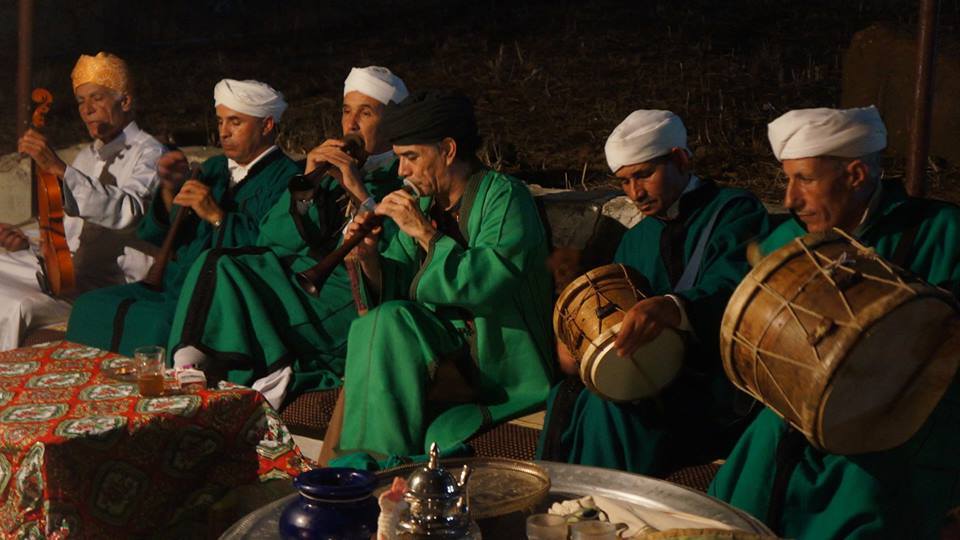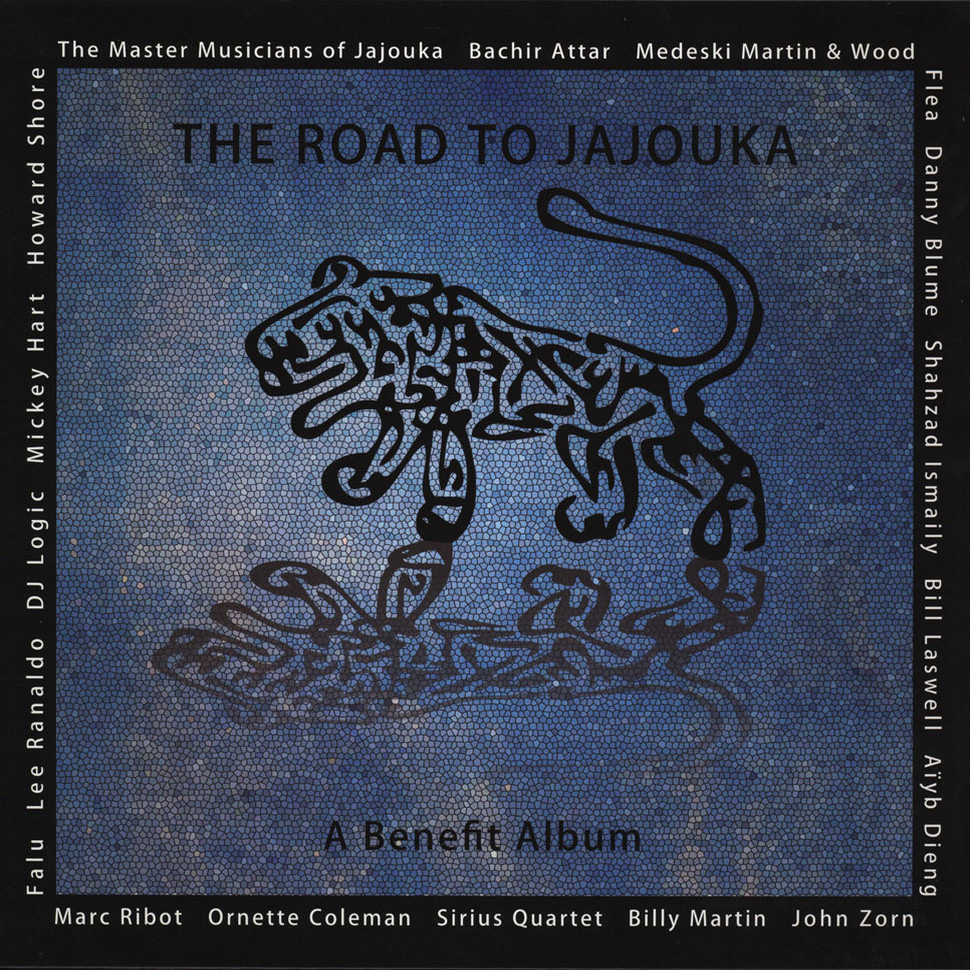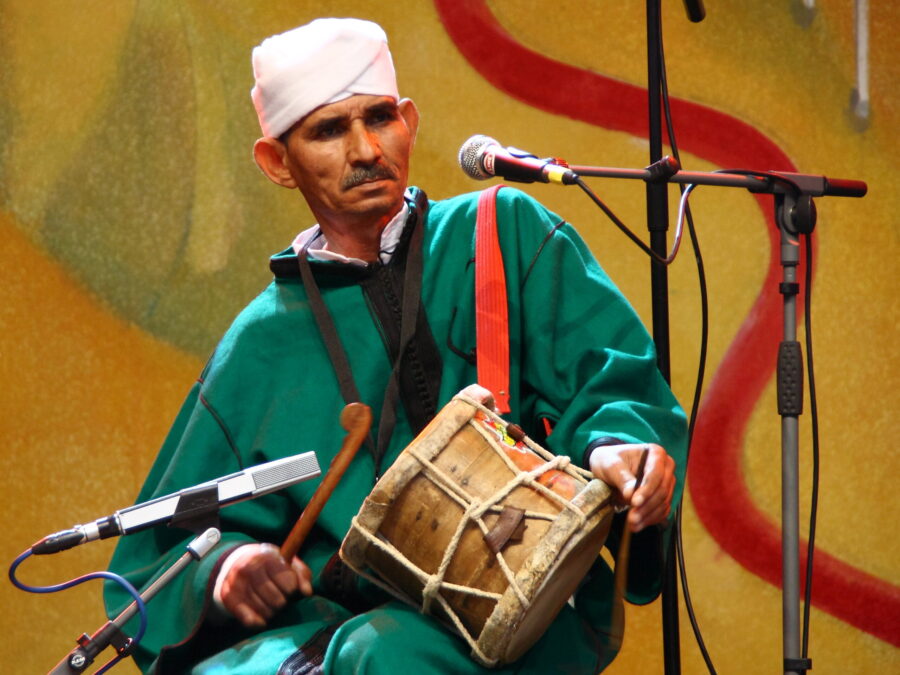Articles
Jajouka, Sufi music for intercultural dialogue
Article author: Dr Mohamed Chtatou
Date of publication of the article: 30/08/2021
Year of publication: 2021
Article theme: Art, History, Interfaith, Music, Religions.
“The Master Musicians music is one of the great legal highs, a thundering, transporting chorale of undulating drones and shrill, ecstatic fanfare…”, Rolling Stone
“a firestorm of sound”, New York Times
Morocco is a crossroad country, a country where different cultures, civilizations, languages, beliefs and religions meet and coexist in total harmony. The country distinguishes itself by Amazigh/Berber, Arab, Jewish, Mediterranean and African cultural influences that Moroccan culture is hugely proud of nowadays and which are inscribed in gold in the Moroccan constitution of 2011.[i]
At different periods of its millenary history, Morocco was invaded by the Phoenicians, the Carthaginians, the Romans, the Vandals, the Arabs, the Portuguese, the Spanish and the French cultural diversity and tolerance are not new concepts for the average Moroccan, but these notions are well buried in his past, his subconscious and culture. They can be easily detected in his daily verbal language, his body linguistic expressions and even his religious beliefs, without forcibly forgetting his material and immaterial patrimony.
A cultural melting pot
At the northeastern part of the town of Ksar Kabir, in the northwestern part of Morocco, there is a tiny village called Tatoft, where resides a religious brotherhood of a singular nature: the Jajouka[ii] of Ahl Srif, a group that practices spiritual trance music that is supposed to cure those followers that are possessed by evil spirits, chief among which the jnoun.[iii]
Arian Fariborz introduces the Jajouka musicians in the following terms:[iv]
“Joujouka is a small insignificant village of 500 people on the edge of the Rif Mountains in northern Morocco: its whitewashed houses have blue painted doors and window frames. A stony path lined with luxuriantly overgrown cactuses and sheer rock leads over a hill to the village mosque and the school.
But this isn’t an ordinary village. Joujouka is the home of a musical elite whose ancestors came from Persia in the ninth and tenth centuries and who are still renowned for the magic and healing effects of the sounds they make.”
These valiant musicians from this village are descendants of the Sufi saint Sidi Ahmed Sheikh, who apparently came from the Machrek around the 13th century for religious preaching but ended up settling down with the Ahl Srif, arabized Amazigh/Berbers from the Rif, teaching them the virtues of Sufism and the art of using music to cure some psychiatric illnesses and disorders.
The Mythical Master Musicians of Jajouka led by Bachir Attar
Since then, the Jajouka have abandoned agriculture, their old occupation, to give their body and soul to spiritual Sufi music. As a counterpart for that, they get donations of seeds and money from their tribe every year in the summer, for their religious role of keepers of the mausoleum of the said saint and the perpetuation of his ancestral tradition of trance music within the region. It is a sort of dime or tithe.
For a lot of Moroccans, the Master Musicians of Jajouka are vulgar ghayata[v] who wander around the souks to beg to rustic people for money. But, in reality, the Jajouka are more than a group of souk players or weddings, baptisms and circumcisions party musicians, they are an example of cultural diversity and tolerance in Morocco both in past and present times.
For some anthropologists, the Jajouka are perpetuating pre-Islamic traditions that date from the times of the Roman Empire, such as the annual fecundity rites of the agricultural calendar. For others, the ghayata of this group reminds them of the ancient divinity Pan and of his desire for sex, which links him to abundance and fecundity. Indeed, in ancient Greek religion and mythology, Pan is the god of the wild, shepherds and flocks, nature of mountain wilds, rustic music and impromptus, and companion of the nymphs. He has the hindquarters legs, and horns of a goat, in the same manner as a faun or satyr.[vi] For the ethnomusicologists, this group perpetuates a unique millenary music.
The Master Musicians of Jajouka were revealed to the public in 1968 by Brian Jones, the star guitarist of the “Rolling Stones”, who had recorded the compositions of their ghaytas in an album titled « Brian Jones Presents the Pipes of Pan at Jajouka. » Many other artists, such as Jimmy Page, Ornette Coleman[vii] and Peter Gabriel had also mentioned them for the originality of their music. The group also had an influence on the poets and the writers of the “Beat Generation,”[viii] such as Williams Burroughs and Paul Bowles, who met them in Tangier. These Moroccan musicians also appeared in the movie « The Sheltering Sky» by Bernardo Bertolucci, after a suggestion from Bowles.
The most relevant aspect about the Jajouka musicians is their ability to successfully assimilate cultural diversity in their musical, cultural and spiritual traditions. Jajouka[ix] are adepts of Sufi music, a music that is supposed to free the soul of its corporal envelope and allow it to overtly communicate with others. Thereby, their music promotes dialogue with others and full brotherhood of men. Proof is that famous musicians of international renown such as Ravi Shankar, Randy Weston, Ornette Coleman, and many others went to their village to meet them, appreciate their ancestral art, and share in their celebrations.
The Jajouka are also known for their musical prowess in playing the oboe (ghayta), known as “circular breathing,” a natural acquired gift that allows them to play air instruments for hours without tiring.
The Boujloudiya festivity
The success of the Jajouka’s tradition resides in the fact that their music, their trances and their religious practices have succeeded in a remarkable way to highlight the fraternity between men and the concordance of cultures, instead of their discordance.
The Boujloudiya is a festivity celebrated by the Jajouka every year in their village, during the Aïd al-Adha or Festival of the Sacrifice. This celebration of trance music, of dance and of theatrical representation commemorates fecundity, but it is, also, a holiday to thank God for his generosity towards men. The Boujloudiya is in fact a meeting point between Christian religion, with its concepts of celibacy and purity of the soul, and of Muslim religion, with its asceticism, its sense of sacrifice and of divine benediction (baraka) mingled with a substratum of pagan spirituality common around the Mediterranean Sea.
The Master Musicians of Jajouka and the Boujloudiya trance dance
This pagan practice was introduced in ancient Morocco by the Romans. In their mythology, the name of this god was Lupercus.[x] Since, this practice is fully immersed in popular Moroccan culture, especially among the rural population, which practices agriculture for its subsistence.
What is interesting is that the temper and the philosophy of the average Moroccan throughout history is his open-mindedness towards the other and his culture, even when this culture is in contradiction with his beliefs.
By nature, the Moroccan individual does not reject anything that comes from elsewhere; he tries instead to assimilate it by his own means and in his own context so that it does not appear to clash with his faith and tradition. It is a big capacity of adaptation with the other and his acceptance: a vivid illustration of the gift of dynamic multiculturalism.
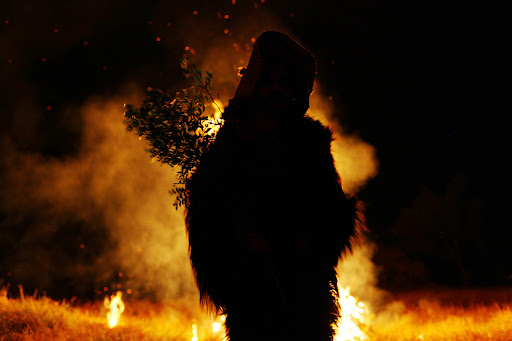
When Sidi Ahmed Sheikh, the famous Sufi, who came from the East, arrived in the region of Tatoft, northern Morocco in the 13th century, he was subjugated by the beauty of the region and the friendship of its habitants, who were, predominantly, Amazigh people arabized over centuries. He taught them the Islamic religion, and while doing so, he understood that they had a love and a gift for music and that they were celebrating pagan rituals at the end of summer. As a good Sufi, infatuated by open-mindedness and soul purity, he assimilated these practices into Islam and so the celebration of the rite of fecundity was moved on to the Hegira Muslim calendar to coincide with the Aid Al-Adha. There, the celebration was called Boujloudiya or Boujloud in arabic and Bouirmawen/ilmawen or Bouisrikhen/islikhen in Tamazight, because the principal character of the rite was wearing the skins of the sacrificed sheep.
Another principal character of the practice is the portrayal of a beautiful village virgin that the god Pan tries to soften up, to benefit from her sexual favors to fecundate her, and, through the same mean, also fecund nature. In the Islamized tradition of the rite, this woman is called Aicha al-Hamqa « Aicha the crazy, » to minimize the rite and make it acceptable towards the shari’a and condemn this illegal sexual act. Islam has also introduced the character of al-Haj (the man who made pilgrimage to Mecca) in the dance act, a man in white djellaba (a local long robe with a hood) to Islamize this pagan tradition, but who plays no particular role in the theatrical celebration.
This practice has been immortalized in the work of William Shakespeare (1564-1616) Julius Caesar, written in 1606. In fact, in the First Act of the Second Scene, Jules Cesar asked Antony, who was prepping for a religious race to touch the hand of Calprunia, his sterile wife, to have heirs for his vast empire.
History and legend
The Jajouka Master Musicians is a male group from Jajouka, a small village at the foot of the Rif Mountains, about 100 kilometers from Morocco’s main port city of Tangier. As residents of the small village of Jajouka in the hills of Jbala in northern Morocco, the Attar family (family of perfumers in Arabic) preserves one of the oldest known musical traditions on the planet. Recognized for their music by the Moroccan royal family for centuries, by jazz masters, rock gods, respected writers and high-level artists from around the world.
But it is not the influence on Western culture that distinguishes Jajouka’s masters. It is the very complex rhythms and melodies that they begin to learn from their fathers in childhood, which, if practiced all their lives, allows them to become real ma’almin or Masters. These skills and secrets of Jajouka’s Master Musicians have been passed down from generation to generation, through centuries of struggle and hard work.
Neil Strauss in an article written for the New York Times describes the Master Musicians as follows:[xi]
“Some think of jajouka as trance music, with its wailing double-reed pipes and frame drums, but Mr. Davis was attracted to it as fusion music. “I think of it as a mixture of Moorish melodies from the lost world of Andalusian Spain, a North African backbeat, and this survival of very old Arcadian music, the music of the ancient world. It’s a heady brew.” »
Jajouka’s Master Musicians play a variety of folk music, old and newly written on traditional local instruments. Most of the compositions in their extensive repertoire are unique to the Attar family and their traditions in Jajouka. Boujloudiya, the trance music of the “father of the skins”, and Boujloud, is played in the village during the festival of Eid al-Kebir, Khamsa ou Khamsine, their oldest and most complex musical number, has been played for centuries by the Jajouka Masters for the sultan, both in his palace and on the battlefield. Hadra appeals to the spiritual energy of the saint buried in Jajouka, Sidi Ahmed Sheikh, who would have blessed the Attar family and their music with baraka and the power to heal people with mental and physical illnesses.
Drums and trance
Jajouka’s Master Musicians are Sufi trance musicians. They play a form of trance music that is used to heal mental disorders and psychological mistrust and crude violence. Every year in the village, a boy is sewn into goat skins to dance under the name of Boujloud, which appears to Westerners as Pan. The goat god playing the flute is the protector of the shepherds who brings fertility to the Spring. The musicians play ancient music to bring the Boujloud back to his cave. After the beast is soothed by their music, they can expect a good harvest. Women affected by its palm leaf fronds will have healthy children and the whole world will bask in happiness and bliss.
The remarkable music played by Jajouka’s Master Musicians is thousands of years old. In the 13th century, as the Sufi saint Sidi Ahmed Sheikh arrived in the village, he wrote music for the ancestors of the Masters that could heal disturbed spirits. Today’s Masters are blessed with the baraka or the spirit of their saint and use touch and prayer to heal.
Music itself is considered part of the Sufi tradition of Islam. Before the colonization of Morocco by France and Spain, the Master Musicians of the village were the royal musicians of the sultans. In past centuries, the Master Musicians of the village of Jajouka had been excused by the country’s leaders for manual labor, goat farming and agriculture, in order to concentrate on their music, as the powerful trance rhythms and buzzing woods were traditionally considered to have the power to heal by sound the sick and the disturbed.
Jajouka and popular culture
The music of the Master Musicians has been described as “a storm of sound” (New York Times). Embraced in the 1950s by artist Brion Gysin and writer Paul Bowles, in the 1960s, the village of Jajouka became the Mecca for celebrities such as the Rolling Stones, Ornette Coleman and Timothy Leary, etc.
The Master Musicians of Jajouka have a long history recorded by Western artists. Arnold Stahl produced a disc, “Tribe Ahl Srif: Master Musicians of Jajouka,” recorded on site as part of a documentary film written and produced by Stahl. This double album was released in the early 1970s by the Musical Heritage Society. During the 1970s, the French label Disque Arion released a single album of the same music, produced by Stahl and entitled: “The Rif: The Ahl Srif Tribe.” Both albums are credited to Jajouka’s Master Musicians (or Jajouka Master Musicians). The name Master Musicians of Jajouka was first used by William S. Burroughs in the 1950s, by Timothy Leary and Rosemary Woodruff Leary in the 1960s and 1970s, and by Brian Jones L.P. published in 1971. In the 1980s, the musicians were sometimes called Jahjouka’s Master Musicians, Jajouka’s Master Musicians and Joujouka’s Master Musicians in both articles and on official documents.
The music genres of Jajouka
Khamsa ou Khamsine (55):
Khamsa ou Khamsine literally translates into the number fifty-five in Arabic. This is the number of times of a very complex rhythmic cycle performed by the Master Musicians of Jajouka. It is also one piece with the same title Khamsa ou Khamsine which has the form of a suite with several sections reserved for major transits or events. The exclusive tradition of interpreting this piece belongs only to Jajouka’s Master Musicians and is perhaps among their oldest traditions. It also shows the mastery of these instruments by the musicians, the ghayta and the tbel, as well as their intensive use in parallel. Because of its rhythmic and harmonic complexity, only the real ma’alam (master musician) can play it.
In ancient times, khamsa or Khamsine was performed by both small ensembles and an orchestra of up to 30 ghayta musicians and 20 tbel musicians. It is highly melodic, intense and beautiful.
Hadj Abdesalam Attar, the father of Bachir Attar, would lead the group by repeating the very complex rhythm by tapping his foot on the ground. In the past, when an important visitor came to the Sultan’s palace, this suite was performed in their honor as a welcome and an initiation. Some sections could also be played when the musicians accompany the sultan to battle as an anthem and prelude to action.
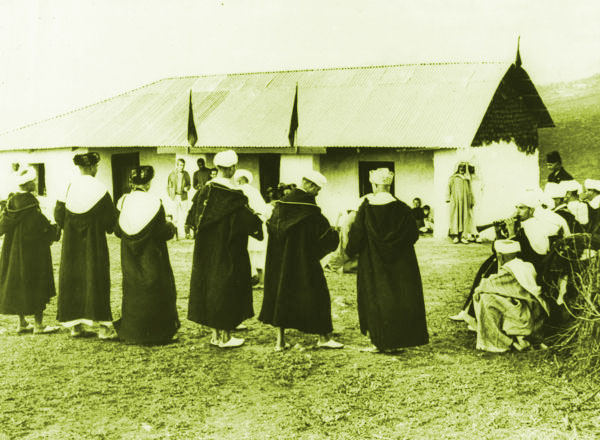
Hadra
Hadra means “presence” in Arabic, presence of good spirits and saints and the propagation of their goodness to men, dwellings, fields, and animals. In the context of Islam, it is the term given to collective supererogatory rituals practiced by mystical Sufi orders. In many cases, it is accompanied by trance-inducing music. In Jajouka, it is a sacred music and perhaps the most important tradition preserved by the Master Musicians of Jajouka.
The Saint, Sidi Ahmed Sheikh, their ancestral spiritual leader, passed it on to them and blessed the music with a powerful healing property or baraka (divine gift). This is the essence of Jajouka: peace, harmony, love and tolerance. Many people suffering from physical and mental illnesses have been cured by Hadra music for hundreds of years.
Traditionally, a mentally unstable man will be brought to the village, often with his wrists tied to a tree near the mausoleum of Sidi Ahmed Sheikh. The musicians play Hadra piece for long periods, sometimes several days, a week until he starts to wake up and actually listen to superior reasoning. When the musicians notice his reaction to the planned sound healing, the rhythm accelerates and builds to a crescendo to the point that the unstable individual begins to dance until possible collapse, a synonymous of healing and release of his soul from the fetters of evil possession. As a result of this prayer, the instruments are passed over his body and, when he wakes up, he is deemed cured. This music has a slow introductory section, with a long, complex and soothing rhythmic loop that supports an equally long and complex melody. This slow introductory section is followed by a faster rhythmic version. Later, the dance section follows, to be concluded by another slow section.
Boujloudiya
When the feast of sacrifice arrives on the tenth day of Dhu al-Hijjah month of the Islamic calender, the villagers of Jajouka know that Boujloud will be upon them. That night, Boujloud (the one who wears skins) is not only covered with tree branches and shrubs are attached to him. A bonfire is built in the centre of the village square, the only light will come from its flames. Once the ghaytas have started to play, there is not even a fraction of a second of silence for the rest of the night; there is no singing, only the shrill of twenty oboes supported by the inexorable beat of the drum tbel. One does not see the Boujloud arrive; he suddenly finds himself between the fire and the circle of spectators, a dark figure tapping his bare feet on the earth, the dancer holding in his hand a branch, occasionally striking a spectator. The screams caused by his gesture are covered by music. What began as a concert became a visible spectacle, a ritual. As this metamorphosis has taken place, the element of time is no longer present. Finally, when the observer’s tension decreases, Boujloud disappears in the same way he entered the ring. The show has become a concert again, the performers have entered the notes they play and it is now that they produce the most passionate and exciting moments of the night: the endless sweet trance leading to trance. A legend surrounds Boujloudiya: if the Master Musicians stop playing the flute, the world would come to an end because such music soothes life and keeps evil away, far away.
Taqtouka al- jabaliya
It is the daily folk music of the Jbala country, played on gambri, lira, kamanja and tbel. They are popular songs about unrequited love, wine-drinking and debauchery but also piety, love of the prophet and of the land of ancestors. It is a softer and more ethereal melody of everyday life.
The Master Musicians play this music for festive occasions such as weddings or baptism or tribal reconciliation. The Taqtouka music is accompanied by dancing performed by young handsome men or boys dressed in women clothing while spectators sip at glasses of sweet mint tea and smoke pot from their traditional long earthen pipes known as sabsi.
Traditionally Taqtouka music is a genre that celebrates all that is illicit haram in Islam: wine known as sahba, sex, and herb-smoking. People will spend a whole night indulging in illicit practices, once in a while, and the next day at dawn they will make big ablutions and resume praying and being a pious Muslim and good family chief and straight husband.
Royal recognition
Traditionally, the Master Musicians of Jajouka had in their possession sealed decrees that gave them the title of playing for the reigning Sultan of Morocco. This music is completely different from the passionate and frenzied Boujloudiya and is played on small bamboo flutes, gambri, violin and drums. They used to take over the leadership of the army and announce the sultan’s arrival in a new city. This music was also to wake up the sultan in the morning, make him fall asleep at night and, in general, create the atmosphere in which the sultan lived, ruled and dominated his subjects.
These decrees were addressed to the musicians with extraordinary respect and freed them from all work, allowing them to take tithing from all cultures cultivated around Jajouka. These roles were renewed when the Alawite family, the ancestors of the current Moroccan king, came to power in the 17th century. However, this vital task was lost at the beginning of the last century with the partition of Morocco, at the beginning of the twentieth century, by France and Spain, when the Jajouka village found itself on the wrong side of the border and cut off from its beloved monarch.
You can follow Professor Mohamed CHTATOU on Twitter: @Ayurinu
References
[i] https://www.constituteproject.org/constitution/Morocco_2011.pdf
[ii] Cf . M. Chtatou ; « The Magical World of the Master Musicians of Jahjouka » in BRISMES Proceedings of the 1986 Conference on Middle Eastern Studies. Ed. L.D. Lanthan. Oxford : British Society of Middle Eastern Studies, 1968.
[iii] Jnoun, pl. jenn : evil spirits in the oral cultural and popular Moroccan tradition.
[iv] https://en.qantara.de/content/the-master-musicians-of-joujouka-the-faded-myth-of-the-goat-god
[v] Ghayta, air musical instrument. Player usually called ghayat.
[vi] https://greekgodsandgoddesses.net/gods/pan/
[vii] Cf. R. williams. « Ornette and the Pipes of Jahjouka » in Melody Maker, March 17, 1973, p. 22.
[viii] https://www.britannica.com/art/Beat-movement
[ix] Cf. P. D. Schuyler. « The Master Musicians of Jahjouka » in Natural History 92 :10, pp. 60-69.
[x] https://www.thoughtco.com/the-roman-festival-of-lupercalia-121029
[xi] https://www.nytimes.com/1995/10/12/arts/the-pop-life-057142.html?mcubz=0


